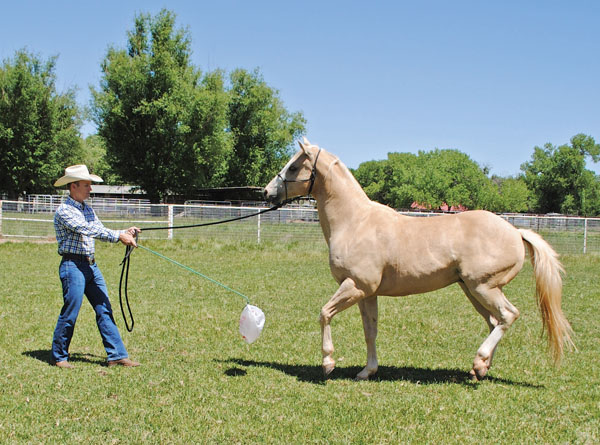Q I have a 5-year-old gelding that spooks at everything. I’ve desensitized him over and over, sacked him out, everything I can think of. But he still spooks at everything. I don’t know what to do anymore; can you offer some advice?

Jessica Helms, Idaho
A I’d need more details about the horse’s general demeanor when he’s at work as well as when he’s just being a horse, but from what I’ve experienced in my clinics I can say that the behavior you describe is often a “people problem” rather than a “horse problem.” Here I’ll cover two ways the rider can be the problem, and then offer my method for making a horse more comfortable with a stimulus. In this case, I’ll present a plastic bag as a stimulus, but it could be a saddle pad, a hose, or anything else.
Rider on a Mission
Any time you approach a horse like you’re going to do something to him, he’s going to react negatively. It’s his prey response to stay safe and alive by spooking and trying to leave when something approaches him aggressively.
If you think about it, you probably can recall a time when you were on a tight time frame and had to rush through saddling your horse—or maybe that’s just your personality type. I bet that your horse reacts negatively every time you approach him in that manner. It explains why, when you’re in a hurry, your horse is probably hardest to catch. He feels threatened by your demeanor and his flight instinct kicks in.
Changing your approach can drastically change your horse’s response. I’m not saying you should approach him meekly or fearfully, but maybe tone down your mission-like attitude. Slowing down and relaxing can make a big difference.
Inflating the Object
Here’s the other common rider problem: When you introduce a new object to the horse or one that you know the horse spooks at, do you (consciously or unconsciously) make a much bigger deal out of that object than necessary?
This involves the approach I explained earlier, but also your focus. If you storm toward your horse, saddle pad in your outstretched arms, staring at the pad, you’ll definitely set off an alarm for your horse, and he’ll try to flee. He thinks that the pad or bag or other stimulus is out to get him. If you act like the pad isn’t any big deal and approach your horse in a relaxed, calm manner, you’ll probably have a better time at it.
Desensitization Tips
Here are a few tips to keep in mind when you’re getting a horse acclimated to a new object or one that he resents or fears.
Take the focus off the stimulus. I have a young horse I work with that’s very fixated and anxious when he sees a plastic bag. It’s obvious that the trainer before me really focused on forcing him to accept the bag. He just knows that the bag is after him. So when I work with him, I try not to focus on the bag. I don’t let him think it’s a big deal. In one session, I might only be able to longe him while holding the bag in my hand to let him know that I’m not going to do what he thinks I’m going to do. I play dumb, like, “Oh, is that a bag? I didn’t even notice it over there.”
Take small steps toward the end goal. Once the horse is OK with the sack in my hand while longeing, I might move it around. Or I might touch him with the sack, just like another horse might touch him with a swishing tail. It’s all by accident—or at least, that’s how it seems to the horse. If I don’t express an intent, he won’t have as many red flags.
Understand what constitutes acceptance. With this young horse, I can tell that they tried to make him stand still when the bag came out. Just because the horse stands still doesn’t mean he accepts the stimulus. All that means is he’s trying to please you, but you can bet he still has his eye on that bag. True acceptance of an object means the horse has no reaction at all.

Ty Brazeal is a lifelong horseman who specializes in proper foundation training for horses of all ages and disciplines. Many of those he works with go on to compete in reining, roping, barrel racing, competitive trail, and other events. He also helps recreational riders. Brazeal conducts clinics throughout the southwest and California and provides colt-starting and rehabilitation services from his home in Los Lunas, New Mexico (tybrazeal.com).






